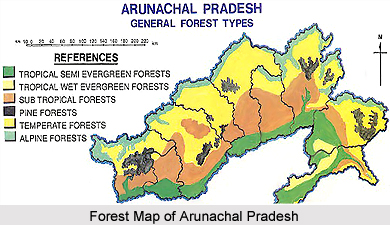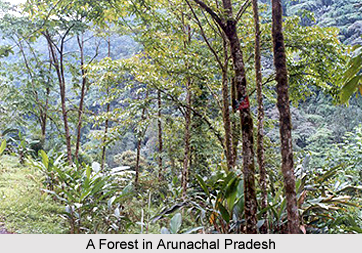 Biological diversity is visible in the forests of Arunachal Pradesh. These forests are home to tribal population which live in close association with nature. They utilize a wide variety of forest resources for survival and source of income. Nature has endowed Arunachal Pradesh with diverse forests and wildlife. These forests presents a landscape of organic variety with several species of plants, terrestrial mammals, birds and a large number of butterflies, insects and reptiles.
Biological diversity is visible in the forests of Arunachal Pradesh. These forests are home to tribal population which live in close association with nature. They utilize a wide variety of forest resources for survival and source of income. Nature has endowed Arunachal Pradesh with diverse forests and wildlife. These forests presents a landscape of organic variety with several species of plants, terrestrial mammals, birds and a large number of butterflies, insects and reptiles.
The forests of Arunachal Pradesh are described below:
Tropical forests
Tropical forests occur up to an elevation of nine hundred metres. They are seen in all districts along the foothills. They can be classified into tropical evergreen forests and tropical semi evergreen forests.
Subtropical Forests
This type occurs in altitudes between 800m to 1900m. They are evergreen and dense in nature. The forests possess diverse species. Climbers, orchids & ferns occur in these forests.
Pine forests
 Pine forests exist in the subtropical and temperate belt. They are seen in the rain shadow area .They are found in Rupa and Dirang valley of Kameng district, Hapoli in Lower Subansiri district , Mechuka, Anini in Dibang valley district and Melinja in Lohit district. In some of these areas it is found in pure stands or frequently mixed with other types of trees too.
Pine forests exist in the subtropical and temperate belt. They are seen in the rain shadow area .They are found in Rupa and Dirang valley of Kameng district, Hapoli in Lower Subansiri district , Mechuka, Anini in Dibang valley district and Melinja in Lohit district. In some of these areas it is found in pure stands or frequently mixed with other types of trees too.
Temperate forests
These forests occur in all districts as a continuous belt. They can be divided into temperate broad leaved forests and temperate conifer forests.
Alpine Forests
Alpine forests occur on the peaks of higher hills which are above an altitude that varies between 4000 m to 5500m. The area is covered by snow for major part of the year. Thereby plant activity is seen only when snow melts. There are no tall trees but dwarf branches and shrubs and mainly herbs with deep roots and cushioned leaves and branches. Bright coloured flowers are seasonal and very attractive. Plants like Rhododendron nivale, Rhodiola, Saxifraga Rheum form the major elements of this peculiar vegetation.
Bamboo Forests and Grasslands
Bamboo trees are seen throughout Arunachal Pradesh. They grow in pure stands with less associated species. Bamboos appear in areas abandoned after shifting cultivation. Bamboos of Arunachal Pradesh are Bambusa tulda, Pseudostachyum polymorphum, Cephalostachyum that occur in higher elevation between 1000m-2000m.
Grasslands are found in plains and at higher elevations. It is maintained through recurring annual fires at higher elevation and excessive grazing at lower elevations. In lower elevation Saccharum spontaneum, Neyraudia reynaudiana, Chrysopogon aciculatus are the common grasslands that are visible.



















